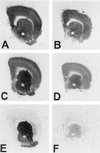Altered brain neurotransmitter receptors in transgenic mice expressing a portion of an abnormal human huntington disease gene
- PMID: 9600992
- PMCID: PMC27817
- DOI: 10.1073/pnas.95.11.6480
Altered brain neurotransmitter receptors in transgenic mice expressing a portion of an abnormal human huntington disease gene
Abstract
Loss of neurotransmitter receptors, especially glutamate and dopamine receptors, is one of the pathologic hallmarks of brains of patients with Huntington disease (HD). Transgenic mice that express exon 1 of an abnormal human HD gene (line R6/2) develop neurologic symptoms at 9-11 weeks of age through an unknown mechanism. Analysis of glutamate receptors (GluRs) in symptomatic 12-week-old R6/2 mice revealed decreases compared with age-matched littermate controls in the type 1 metabotropic GluR (mGluR1), mGluR2, mGluR3, but not the mGluR5 subtype of G protein-linked mGluR, as determined by [3H]glutamate receptor binding, protein immunoblotting, and in situ hybridization. Ionotropic alpha-amino-3-hydroxy-5-methyl-4-isoxazolepropionic acid and kainate receptors were also decreased, while N-methyl-D-aspartic acid receptors were not different compared with controls. Other neurotransmitter receptors known to be affected in HD were also decreased in R6/2 mice, including dopamine and muscarinic cholinergic, but not gamma-aminobutyric acid receptors. D1-like and D2-like dopamine receptor binding was drastically reduced to one-third of control in the brains of 8- and 12-week-old R6/2 mice. In situ hybridization indicated that mGluR and D1 dopamine receptor mRNA were altered as early as 4 weeks of age, long prior to the onset of clinical symptoms. Thus, altered expression of neurotransmitter receptors precedes clinical symptoms in R6/2 mice and may contribute to subsequent pathology.
Figures


Similar articles
-
Partial resistance to malonate-induced striatal cell death in transgenic mouse models of Huntington's disease is dependent on age and CAG repeat length.J Neurochem. 2001 Aug;78(4):694-703. doi: 10.1046/j.1471-4159.2001.00482.x. J Neurochem. 2001. PMID: 11520890
-
Altered neurotransmitter receptor expression in transgenic mouse models of Huntington's disease.Philos Trans R Soc Lond B Biol Sci. 1999 Jun 29;354(1386):981-9. doi: 10.1098/rstb.1999.0449. Philos Trans R Soc Lond B Biol Sci. 1999. PMID: 10434296 Free PMC article. Review.
-
Dopamine-dependent long term potentiation in the dorsal striatum is reduced in the R6/2 mouse model of Huntington's disease.Neuroscience. 2007 Jun 8;146(4):1571-80. doi: 10.1016/j.neuroscience.2007.03.036. Epub 2007 May 2. Neuroscience. 2007. PMID: 17478055
-
Inhibition of tryptophan hydroxylase activity and decreased 5-HT1A receptor binding in a mouse model of Huntington's disease.J Neurochem. 2002 Sep;82(6):1416-23. doi: 10.1046/j.1471-4159.2002.01084.x. J Neurochem. 2002. PMID: 12354289
-
Polyglutamine expansion and Huntington's disease.Biochem Soc Trans. 1998 Aug;26(3):471-5. doi: 10.1042/bst0260471. Biochem Soc Trans. 1998. PMID: 9765898 Review. No abstract available.
Cited by
-
Neurotransmitters and molecular chaperones interactions in cerebral malaria: Is there a missing link?Front Mol Biosci. 2022 Aug 24;9:965569. doi: 10.3389/fmolb.2022.965569. eCollection 2022. Front Mol Biosci. 2022. PMID: 36090033 Free PMC article. Review.
-
Disruption of Purkinje cell function prior to huntingtin accumulation and cell loss in an animal model of Huntington disease.Exp Neurol. 2012 Jul;236(1):171-8. doi: 10.1016/j.expneurol.2012.04.015. Epub 2012 May 2. Exp Neurol. 2012. PMID: 22579526 Free PMC article.
-
Environmental enrichment rescues protein deficits in a mouse model of Huntington's disease, indicating a possible disease mechanism.J Neurosci. 2004 Mar 3;24(9):2270-6. doi: 10.1523/JNEUROSCI.1658-03.2004. J Neurosci. 2004. PMID: 14999077 Free PMC article.
-
Atypical diabetes associated with inclusion formation in the R6/2 mouse model of Huntington's disease is not improved by treatment with hypoglycaemic agents.Exp Brain Res. 2005 Oct;166(2):220-9. doi: 10.1007/s00221-005-2357-z. Epub 2005 Jul 21. Exp Brain Res. 2005. PMID: 16034568
-
Locomotor Behavior and Memory Dysfunction Induced by 3-Nitropropionic Acid in Adult Zebrafish: Modulation of Dopaminergic Signaling.Mol Neurobiol. 2024 Feb;61(2):609-621. doi: 10.1007/s12035-023-03584-5. Epub 2023 Aug 30. Mol Neurobiol. 2024. PMID: 37648841
References
-
- Huntington’s Disease Collaborative Research Group. Cell. 1993;72:971–983. - PubMed
-
- Paulson H L, Fischbeck K H. Annu Rev Neurosci. 1996;19:79–107. - PubMed
-
- Sharp A H, Loev S J, Schilling G, Li S H, Li X J, Bao J, Wagster M V, Kotzuk J A, Steiner J P, Lo A, et al. Neuron. 1995;14:1065–1074. - PubMed
-
- Kosinski C M, Cha J H, Young A B, Persichetti F, MacDonald M, Gusella J F, Penney J B, Standaert D G. Exp Neurol. 1997;144:239–247. - PubMed
Publication types
MeSH terms
Substances
Grants and funding
LinkOut - more resources
Full Text Sources
Other Literature Sources
Medical

